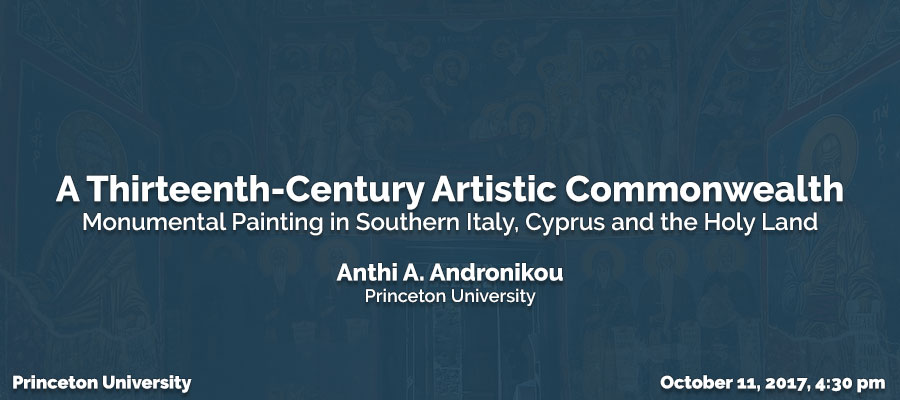A Thirteenth-Century Artistic Commonwealth: Monumental Painting in Southern Italy, Cyprus and the Holy Land, lecture by Anthi A. Andronikou (Mary Seeger O’Boyle Postdoctoral Fellow, Hellenic Studies), Princeton University, October 11, 2017, 4:30 pm
Respondent: Charlie Barber, Art and Archaeology
The visual culture that stems from the creative dialogue between Byzantine art and other Christian artistic idioms in the Levant and southern Italy in the thirteenth century has been previously the subject of a number of scholarly works, which offer a range of style-oriented taxonomical classifications of “Crusader art”. Analysis of monumental painting shows that iconographic and stylistic similarities between southern Italy and Cyprus are not incidental but reflect historical realities. Apulian and Cypriot images are examined in conjunction with the religious practices, social structures and quotidian realities of both regions. Although southern Italian painting has traditionally been assigned a passive role, it should be understood as a living entity actively interacting with contemporary trends in the eastern Mediterranean. Cyprus should no longer be viewed as the leader in these contacts, as historical and visual sources demonstrate that Apulia was an equal artistic player, which had much closer links with the Holy Land than it did with Cyprus. A tripartite artistic commonwealth between southern Italy, Apulia and the Holy Land existed in the medieval Mediterranean.
Anthi Andronikou has a B.A. (2004) in Art History and Archaeology from the University of Athens. After completing her undergraduate studies, she undertook an M.Phil. in Byzantine Art History at the same institution. Anthi also holds an M.Litt. in Late Medieval and Renaissance Italian Art from the University of St. Andrews, where she completed her Ph.D. (2015) in Art History with a dissertation on “Italy and Cyprus: Cross-Currents in Visual Culture (Thirteenth and Fourteenth Centuries).” She has been an awardee of the British School at Rome and the Dumbarton Oaks Research Library and Collection, Harvard, and participated in the early-career research grant “Art of the Crusades: A Re-Evaluation,” led by the SOAS Institute and the Getty Foundation.
